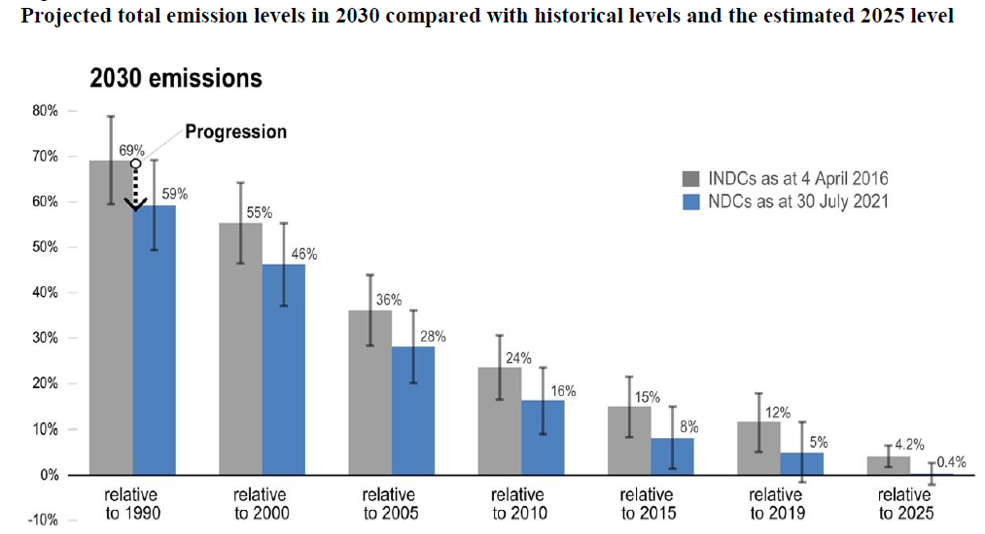The UNFCCC has released its full NDC synthesis report last Friday, 17th of September 2021. Whilst in the previous report only 113 parties had updated or submitted its NDCs targets, which corresponded to 49% of Global GHG emissions, the latest report shows that until 31st of July 2021, all parties had submitted their NDCs. A great progress has been done, as the call on my article from 31st of July.
Implementing those targets requires a collaborative effort, not always well received in spite of the common good all benefit from. The complexity of the system, given the underlying multiple interests and values makes the implementation an odyssey. The seas, currents and waves, through which the Sustainable transformation has been navigating, will take the Planet, Society, Businesses and Governments to lasting Prosperity, as long as compliance is a good practice. The commitments that parties have taken are summarised below in the graphical representation I’ve created.

According to the full NDC synthesis report, most of the parties expect to transit to a decarbonised economy between 2025 and 2030. But as “most” ranges between 41% and 70%, achieving Carbon Neutrality by 2030 and Net-Zero by 2050 has a high variability. To keep in the 1.5ºC global warming trajectory, a 45% reduction on global GHG emissions from 2010 levels by 2030 is requested (AR6). As such, high variability in the commitments makes me forecast dark and heavy skies ahead.
This landscape is easily seen on the below progression chart, “Projected total emissions levels in 2030 compared with historical levels and the estimated 2025 level”, was extracted from the report. Although a progress has been made in 8 percentage points, from the NDCs presented in 2016, alignment with 1.5ºC global warming pathway demands a 52.5% cut on GHG emissions from the latest NDCs. Reaching 26.02 GtCO2eq, implies a sustainable transformation in the economy, only achieved with a common effort as #weareallinthistogether. Many factors will contribute to the full economic decarbonisation. Innovation, collaboration, capital allocation to sustainable investments, policies and regulatory frameworks that enable a just transition, along with a clear strategy and roadmap will be key.


The report does call for urgent bold actions, through different strategies: (1) overperforming current NDCs, (2) update the existent commitments or (3) a mix of overperforming with new extension of NDCs. It suggests material strategies to align with 1.5ºC pathway, namely the halt of coal related investments, a phased-out usage of fossil fuels passengers ICEV; newly constructed buildings net zero energy consumption by 2020 and expanding the forest area. The latter a measure some politicians aiming to win local governments elections are currently promoting in their campaign in Portugal.
As mentioned above in this article, the decarbonisation and consequent socio-economic sustainable transformation demands a significant allocation of capital. Changing finance policy to promote sustainable initiatives is thus imperative. Many central banks have started to take bolder actions to attain a sustainable transformation pushing through its monetary policy instruments. Commercial banks have been requested to conduct stress tests assessing their resilience to climate related risks, which increase as we approach the 1.5ºC trajectory sooner than expected, as IPCCC’s AR6 has recently shown. As it becomes inevitable, what are your thoughts on how to best contribute on the economic sustainable transformation? What actions have you been taking?
For many sustainability has been only a trend and #greenwashing an acceptable practice. Considering its negative effect on the sustainable transformation, could #greenwashing be penalised as negative externality? A proxy of the #opportunitycost and the #welfare loss it generates by not fully delivering the claimed sustainable value, would be a doable penalty to be paid by the #greenwashers. It would also constitute a revenue source to the national and supra-national public finances and be used for the NDCs’ implementation. Hence, the good players would be benefiting from a good behaviour while the free riders will face a lower incentive to cheat. With time, hopefully this extraordinary revenue will diminish.































